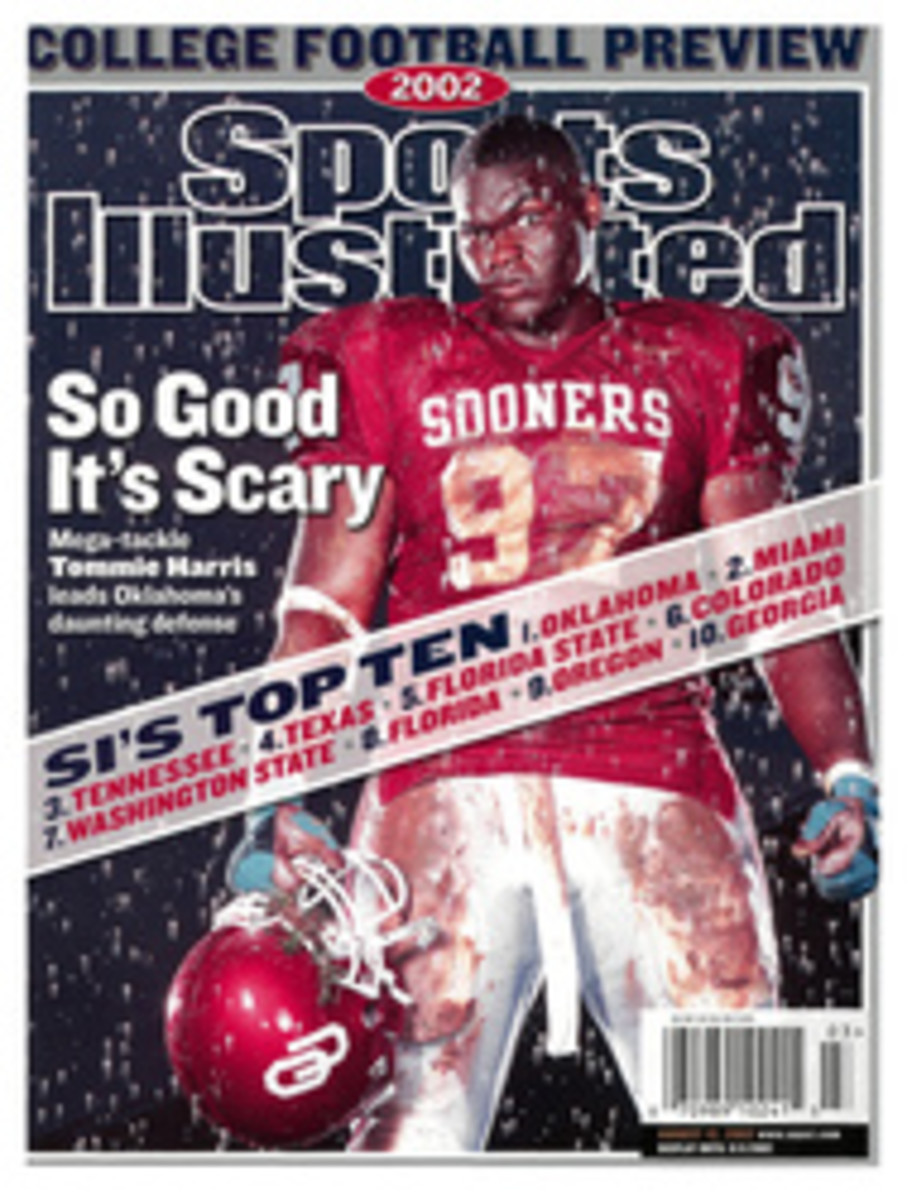
Risky Business In his redesign of Hazeltine, Rees Jones faced his trickiest job ever: improving upon the work of his legendary father, Robert Trent Jones
Rees Jones admits he is disappointed. In this, the summer of his
acclaim--his restoration of Bethpage Black drew as much admiring
attention as the U.S. Open contested on it did--there'll be no
Grand Slam, which means that next week's PGA Championship on his
twice-remodeled Hazeltine is now, well, just another major. Gone
with the wind over Muirfield is the event for the ages, the hype,
the hoopla, the history. "It truly would have been," he says
wistfully, "a Jones family triumph."
Jones, 60, is one of the world's most honored course architects,
respected for original designs such as Atlantic, Nantucket and
Pinehurst No. 7, but it's his work on the resuscitation of such
classics as Baltusrol, the Country Club and Pinehurst No. 2 that
have earned him the moniker of the Open Doctor of his generation.
With Hazeltine, Sahalee, Atlanta Athletic Club and, coming up in
2006, Medinah also on his resume, he could be called the PGA
Physician as well. But before Jones there was another designer
who laid claim to the Open Doctor title--a man with whom Jones had
some history.
By way of explaining that relationship, Jones tells of an
incident that happened to him in the early 1980s. Back then he
was already the head of his own design firm, and during a New
England vacation with his wife, Susan, and their daughters, Alden
and Amy, curiosity lured him to the gates of an exclusive old
club. The architect in him wanted to examine the layout, and the
golfer in him wanted to play it, but he had arrived unannounced
and unsponsored. The pro told him he was trespassing. Jones asked
if an exception could be made since he knew several members.
Again, the pro told him to leave. Jones tried an alternate route:
"I'm in the business. I'm a course architect."
"So," the pro growled, "who do you think you are, Robert Trent
Jones?"
"No," Rees replied, "I'm his son."
And, voila, the gates unlocked. Such is the blessing and the
curse of being a course architect sired by the most prolific and
influential designer ever. Doors open, but establishing one's own
identity can be difficult.
Jones pere may have given his two sons a leg up in the
business--Rees and older brother Robert Trent Jones Jr.
apprenticed under their father after graduating from Yale in the
1960s--but his presence cast a shadow larger than the enormous
greens that were the old man's signature. Emerging would take
time. Rees would have to learn to accommodate the past and
champion an alternate strategy of design from the one promoted by
his father. En route he would present a fascinating case study on
the interaction of fathers and sons, the most complex chapter
revolving around Hazeltine.
Trent, who was 93 when he died in 2000, championed a look-forward
style that he believed would hold up to evolutionary changes in
the game. Heroic and penal, the style encouraged power over
finesse and filled the landscape with massive problems--lots of
water, sharp doglegs, blind shots and protected greens with more
contours than a '50s starlet. It was a style fit for championship
play, precisely what the founders of Hazeltine National Golf Club
envisioned for their piece of prairie in Chaska, Minn.
Robert Trent Jones's championship bona fides were certainly in
order, Jones having doctored Oakland Hills (1950), Baltusrol
('52), Olympic ('54), Congressional ('62) and Oak Hill ('67) for
U.S. Opens. In 1970, eight years after Hazeltine opened, it would
host an Open of its own--to uniformly bad reviews.
The week before the tournament Jack Nicklaus lambasted
Hazeltine's array of blind shots in a story in SI. "Dad went
white," says Robert Jr. "He was very troubled by it." Trent flew
to Hazeltine and walked the course a couple of days before the
Open, and at a pretournament press conference the next morning
defended his work. "He rose to the occasion," says Rees, who
watched from the wings. "He justified his design." Then, in the
roaring winds of the first day of competition--Nicklaus shot an
81--the players came in howling, none louder than Dave Hill, who
said, "All [Hazeltine] lacks is 80 acres of corn and a few cows.
They ruined a good farm when they built this course." His
suggestion: "Plow it up and start over."
"That was painful, too," says Robert Jr., "but while Dad
respected Nicklaus as a true champion and was stung by what he
had written, he thought Hill was just trying to be funny."
Longtime Hazeltine member Reed Mackenzie, who is president of the
USGA, agrees. "I don't think anyone was particularly offended,"
he says. Mackenzie remembers a lot of good-natured mooing from
the gallery when Hill teed off on Friday morning. "It was all in
good fun."
For Rees, the flap recalled an earlier pasting his father took,
at Oakland Hills in 1951. With Ben Hogan leading the charge, the
players accused Trent of being a monster maker. Young Rees
changed that to master maker in his mind. "Believe me, we were
used to the criticism," Rees says. Still, says Mackenzie, "when
the criticisms were repeated over and over again, we realized we
had a problem."
Trent immediately began remodeling Hazeltine after the Open. He
straightened doglegs, graded fairways for clearer sight lines
and, most significantly, turned the 16th hole from a nondescript
par-3 into a terrifying par-4 with marsh and trees to the right,
a ditch to the left and Lake Hazeltine in play around a new
peninsula green.
Rees continued working for his father until 1974, when he hung
out his own shingle, not far from his father's, in Montclair,
N.J., where the Jones family grew up. By the mid-'80s he had
found his future in the strangest place: the game's past. While
his earliest designs followed his father's target-golf mold, the
years he had spent playing strategic, angle-driven courses
designed by Alister Mackenzie, Donald Ross and A.W. Tillinghast
had left an imprint. "The old masters cared more about the mental
side of the game," Jones says. Drawn to that, a neoclassicist was
born.
Nowhere were Jones's values more evident than in his delicate
restoration of the Country Club, in Brookline, Mass., for the
1988 Open. "To have been selected by Brookline to redo such a
revered, sacred venue was like I'd died and gone to heaven,"
Jones says. When Rees got the job, Trent sat down with him and
reinforced the significance of the grounds where Francis Ouimet
shocked American golf to life by winning the 1913 Open. "Since I
didn't really have my father around much when I was a kid, it was
great to have this interaction," Rees says. "He was very proud of
me."
Yet one shadow remained. "I think he was probably surprised that
I was chosen for the job and he wasn't," Rees adds. Trent was
still, after all, the Open Doctor. "He was amazed at how
successfully I was received."
With the Open set to return to Hazeltine in 1991, that course
also needed tweaking--and redemption. Trent was grieving over the
death of his wife, Ione, in '87, and had begun slowing down. "We
really had to persuade Rees," says Mackenzie. "To restore the
reputation of Hazeltine, we wanted to go in a slightly different
direction from his father, but we didn't want a total stranger to
his father's thinking. This would be the first time he had worked
on one of his father's courses. It was a little dicey." Like an
intern treating the chief of staff.
Rees knew the risk, but he also sensed the reward. "No matter how
much work had already been done by my father, the world was still
thinking of the old Hazeltine," he says. "This was our chance to
change that impression." So he went to work, bringing more
definition to fairways and greens, raising tees, fortifying hole
locations, lengthening and, in his most dramatic addition,
turning the drainage ditch to the left of the 16th fairway into a
stream.
"This would be the 70th hole of the Open," Jones says, and the
closer a tee shot could be played to the hazard, the better the
angle to the green. "I didn't want a ditch. I didn't want any
debate over drops or fairness, so I made it as defined a hazard
as I could--with water." A father-son conspiracy if ever there was
one. "I built the 16th so the players wouldn't complain about the
other 17 holes."
Instead of complaints, Jones drew hosannas. Johnny Miller called
16 "probably the hardest par-4 I've ever played." Even Nicklaus
took a mulligan, saying, "You need this kind of a hole to give a
tournament more excitement, more controversy."
There was someone more significant to please. The renovation
complete, father and son toured the course. "He approved," says
Rees. "This was where I finally thought he accepted me as an
equal. This is where he passed the baton. This is where I think I
made the major break. It was time. It was something I needed to
do because I'm Rees Jones. I don't have my father's name."
Says brother Robert Jr., who does: "We both wanted our father's
approval as course architects. In that sense I think Hazeltine
was my brother's epiphany."
Not surprisingly Hazeltine called on Rees again when planning
began for next week's PGA. He returned to freshen the bunkers,
add about 200 yards, straighten the par-5 15th and build a series
of treacherous bunkers on its flanks. "But 16 is obviously the
hole that still captures the imagination of all players," says
Jones.
So, on a stunningly crisp Minnesota morning less than two days
after the dream of the Grand Slam was deferred, Jones arrived at
Hazeltine and headed directly to the 16th hole. What he saw
erased his disappointment. The fairway has been cut 15 dastardly
paces closer to the stream than it had been during the 1991 Open.
"This is the greatest," says Rees. "It's going to come into play.
I had done all this work for the Open, and the creek wasn't
really in play. Now it's a meaningful hazard."
And a meaningful coda to the saga of father, son and golf
course. "My father's dream has been realized, and I'm part of
that dream," Rees says.
Yet, "It would have been a glorifying experience for me to have
two of my redos be part of Tiger's slam, but he's only 26. Maybe
he'll do it in 2005 when I've got the Open at Pinehurst and the
PGA at Baltusrol. Maybe that'll be the year."
That would be a Jones family triumph worth waiting for.
COLOR PHOTO: PHOTOGRAPH BY JAMES SCHNEPF SWEET 16? With the addition of a stream on the left side of 16, Rees perfected a hole that could play a critical role in the PGA.
COLOR PHOTO: KERI PICKETT WET AND WILD Rees inspects his creek at 16, which he says he built to eliminate questions about drops or fairness.
COLOR PHOTO FAMILY AFFAIR Trent with sons Robert (left) and Rees at Hazeltine in '91.
"We both wanted our father's approval," says Robert Jr. "In that
sense Hazeltine was my brother's epiphany."

